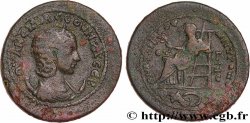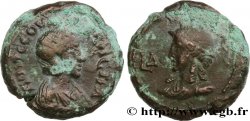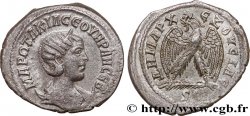E-auction 165-101750 - bpv_154040 - OTACILIA SEVERA Tétradrachme syro-phénicien
Devi Sign-in ed essere un offerente approvato fare un'offerta, Login per fare offerte. Conti sono soggetti ad approvazione e di approvazione sono raggiunti entro 48 ore. Non aspettare fino al giorno di una vendita si chiude per registrarti.Confermando la tua offerta su questo oggetto ti impegni ad un contratto legalmente vincolante per l'acquisto di questo prodotto e fare clic su «offerta» costituisce accettazione dei termini di utilizzo de e-auctions cgb.fr.
Offerta deve essere collocato in euro gli importi interi vendita only.The si chiuderà al momento sulla descrizione dell'oggetto, eventuali offerte pervenute al sito dopo l'orario di chiusura non verranno eseguite. Volte transmition possono variare e le offerte potrebbero essere respinto se si attende per gli ultimi secondi. Per ulteriori informazioni ckeck le FAQ.
SENZA COSTI PER GLI ACQUIRENTI.
SENZA COSTI PER GLI ACQUIRENTI.
| Valutazione : | 190 € |
| Prezzo : | 57 € |
| Offerta maxima : | 60 € |
| Data di fine vendita : | 13 giugno 2016 15:15:30 |
| partecipanti : | 7 partecipanti |
Tipo : Tétradrachme syro-phénicien
Data: 248
Nome della officina / città: Antioche, Syrie, Séleucie et Piérie
Metallo : billone
Diametro : 28,00 mm
Asse di coniazione : 12 h.
Peso : 12,18 g.
Grado di rarità : R2
Commenti sullo stato di conservazione:
Frappe correctement centrée sur un flan régulier, faible usure mais surface légèrement piquée
N° nelle opere di riferimento :
Pedigree :
Cet exemplaire, qui provient de la trouvaille dite de Jordanie 1930, est le 0381_003 de la base TSP
Diritto
Descrittivo diritto : Buste drapé et diadémé d’Otacilia Sévéra à gauche, les cheveux remontés en tresse sur la tête, posé sur un croissant de lune, vu de trois quarts en avant (L16).
Legenda diritto : MAR WTAKIL SEOUHRAN SEB
Traduzione diritto : (Marcia Otacilia Severa augusta).
Rovescio
Titolatura rovescio : ANTIOXIA / S|C À L’EXERGUE.
Descrittivo rovescio : Aigle debout à gauche, les ailes déployées, tête et queue à droite, tenant une couronne feuillée dans son bec.
Legenda rovescio : DHMARC - EX OUSIAS UPATOG
Traduzione rovescio : (Revêtu de la puissance tribunitienne / Consul pour la troisième fois / avec l’accord du Sénat d’Antioche).
Commento
Les frappes de Philippe II datées du troisième consulat, comme celles d’Otacilie Sévère d’ailleurs, portent les titres de Philippe Père. Elles se distinguent entre elles par différents aigles de revers et un portrait à droite ou à gauche.
Il faut noter que si Philippe affectionne particulièrement la couronne radiée solaire dans ses frappes de tétradrachmes (sans que cela ait la moindre influence sur la valeur faciale de la monnaie, contrairement à ce qui se produit pour les antoniniens), tous les bustes de son épouse sont posés sur un croissant lunaire.
En abordant les frappes du 3e consulat, on remarque l’absence complète de frappes datées du deuxième consulat, bien que le deuxième consulat de Philippe et de sa famille existe indubitablement à Rome, y compris sur les émissions monétaires. Interruption des frappes ou comput différent à Antioche qu’à Rome ? Nous penchons pour la deuxième solution, pour deux raisons.
Tout d’abord la continuité stylistique : tant pour les revers que pour les droits, il n’y a pas de rupture, alors que l’on aurait pu présumer une certaine normalisation après une interruption des frappes. De plus, celle-ci se produira effectivement pour les frappes datées du quatrième consulat avec un style d’aigle unique, suivie à la fin par une nouveauté encore plus marquante, l’introduction d’officines indiquées sur les monnaies.
Ensuite, il existe à Antioche de très nombreuses frappes datées d’un quatrième consulat de Philippe l’Arabe dont nous ne trouvons pas trace à Rome. Il est extrêmement regrettable que les quelques informations dont nous disposons sur le Sénat d’Antioche soient largement plus tardives (4e et 5e siècle) car les émissions de tétradrachmes laissent à penser que non seulement le Sénat d’Antioche manifestait son indépendance envers Rome en frappant de l’argent avec la titulature “SC / ANTIOXIA” mais encore qu’il avait son propre comput impérial sous Philippe.
L’apparition de cette exergue et la disparition de la palme sont caractéristiques des 3e et 4e consulat mais les styles des aigles ne se normaliseront qu’au 4e.
On note que les sigma sont gravés en C.
Dans la base TSP maintenue par Michel Prieur, quatorze exemplaires sont maintenant répertoriés pour ce type, deux en musées à Oxford et Gaziantep.
The coins of Philip II dated from the third consulate, like those of Otacilia Severus, bear the titles of Philip the Father. They are distinguished from each other by different reverse eagles and a portrait on the right or left.
It should be noted that while Philip was particularly fond of the radiating solar crown in his tetradrachm strikes (without this having the slightest influence on the face value of the coin, unlike what happens with the antoninianus), all the busts of his wife are placed on a lunar crescent..
When approaching the strikes of the 3rd consulate, we notice the complete absence of strikes dated from the second consulate, although the second consulate of Philip and his family undoubtedly existed in Rome, including on monetary issues.. Was the minting interrupted or was the calculation different in Antioch than in Rome? We are inclined to choose the second solution, for two reasons..
First of all, stylistic continuity: for both the backhands and the forehands, there is no break, whereas one might have assumed a certain standardization after an interruption in the strokes. Furthermore, this will actually occur for the strikes dated from the fourth consulate with a unique eagle style, followed at the end by an even more striking novelty, the introduction of offices indicated on the coins..
Then, in Antioch there are many strikes dated to a fourth consulate of Philip the Arab, of which we find no trace in Rome.. It is extremely regrettable that the little information we have on the Senate of Antioch is much later (4th and 5th century) because the issues of tetradrachms suggest that not only did the Senate of Antioch demonstrate its independence from Rome by minting coin with the title “SC / ANTIOXIA” but also that it had its own imperial computus under Philip.
The appearance of this exergue and the disappearance of the palm are characteristic of the 3rd and 4th consulate but the styles of the eagles will not become standardized until the 4th.
Note that the sigmas are engraved in C.
In the TSP database maintained by Michel Prieur, fourteen examples are now listed for this type, two in museums in Oxford and Gaziantep
Il faut noter que si Philippe affectionne particulièrement la couronne radiée solaire dans ses frappes de tétradrachmes (sans que cela ait la moindre influence sur la valeur faciale de la monnaie, contrairement à ce qui se produit pour les antoniniens), tous les bustes de son épouse sont posés sur un croissant lunaire.
En abordant les frappes du 3e consulat, on remarque l’absence complète de frappes datées du deuxième consulat, bien que le deuxième consulat de Philippe et de sa famille existe indubitablement à Rome, y compris sur les émissions monétaires. Interruption des frappes ou comput différent à Antioche qu’à Rome ? Nous penchons pour la deuxième solution, pour deux raisons.
Tout d’abord la continuité stylistique : tant pour les revers que pour les droits, il n’y a pas de rupture, alors que l’on aurait pu présumer une certaine normalisation après une interruption des frappes. De plus, celle-ci se produira effectivement pour les frappes datées du quatrième consulat avec un style d’aigle unique, suivie à la fin par une nouveauté encore plus marquante, l’introduction d’officines indiquées sur les monnaies.
Ensuite, il existe à Antioche de très nombreuses frappes datées d’un quatrième consulat de Philippe l’Arabe dont nous ne trouvons pas trace à Rome. Il est extrêmement regrettable que les quelques informations dont nous disposons sur le Sénat d’Antioche soient largement plus tardives (4e et 5e siècle) car les émissions de tétradrachmes laissent à penser que non seulement le Sénat d’Antioche manifestait son indépendance envers Rome en frappant de l’argent avec la titulature “SC / ANTIOXIA” mais encore qu’il avait son propre comput impérial sous Philippe.
L’apparition de cette exergue et la disparition de la palme sont caractéristiques des 3e et 4e consulat mais les styles des aigles ne se normaliseront qu’au 4e.
On note que les sigma sont gravés en C.
Dans la base TSP maintenue par Michel Prieur, quatorze exemplaires sont maintenant répertoriés pour ce type, deux en musées à Oxford et Gaziantep.
The coins of Philip II dated from the third consulate, like those of Otacilia Severus, bear the titles of Philip the Father. They are distinguished from each other by different reverse eagles and a portrait on the right or left.
It should be noted that while Philip was particularly fond of the radiating solar crown in his tetradrachm strikes (without this having the slightest influence on the face value of the coin, unlike what happens with the antoninianus), all the busts of his wife are placed on a lunar crescent..
When approaching the strikes of the 3rd consulate, we notice the complete absence of strikes dated from the second consulate, although the second consulate of Philip and his family undoubtedly existed in Rome, including on monetary issues.. Was the minting interrupted or was the calculation different in Antioch than in Rome? We are inclined to choose the second solution, for two reasons..
First of all, stylistic continuity: for both the backhands and the forehands, there is no break, whereas one might have assumed a certain standardization after an interruption in the strokes. Furthermore, this will actually occur for the strikes dated from the fourth consulate with a unique eagle style, followed at the end by an even more striking novelty, the introduction of offices indicated on the coins..
Then, in Antioch there are many strikes dated to a fourth consulate of Philip the Arab, of which we find no trace in Rome.. It is extremely regrettable that the little information we have on the Senate of Antioch is much later (4th and 5th century) because the issues of tetradrachms suggest that not only did the Senate of Antioch demonstrate its independence from Rome by minting coin with the title “SC / ANTIOXIA” but also that it had its own imperial computus under Philip.
The appearance of this exergue and the disappearance of the palm are characteristic of the 3rd and 4th consulate but the styles of the eagles will not become standardized until the 4th.
Note that the sigmas are engraved in C.
In the TSP database maintained by Michel Prieur, fourteen examples are now listed for this type, two in museums in Oxford and Gaziantep







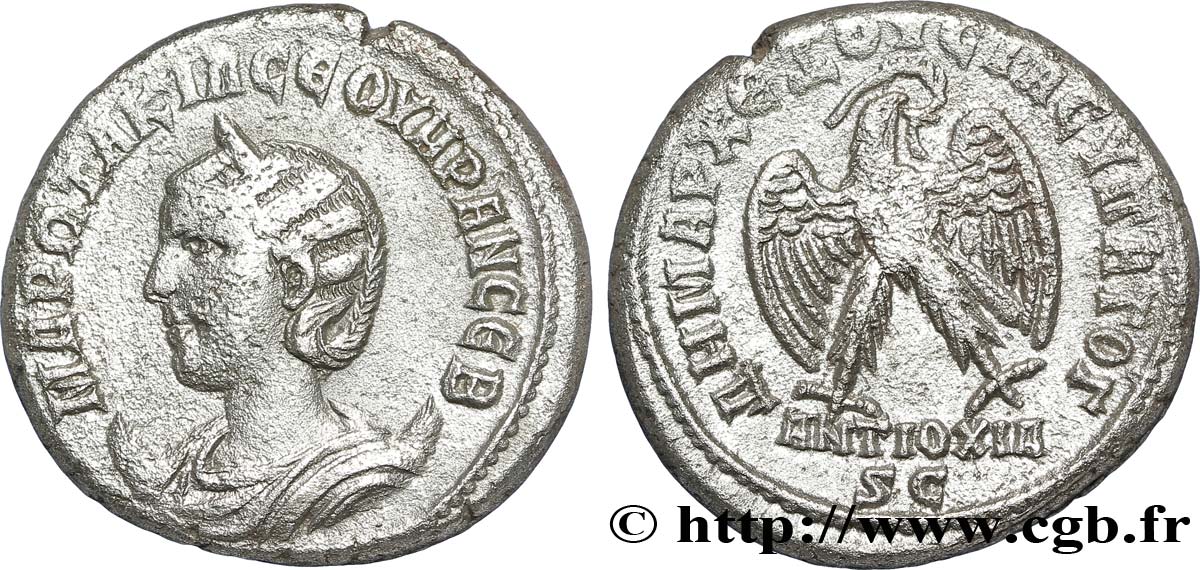
 Segnalare un errore
Segnalare un errore Stampate la pagina
Stampate la pagina Condividi mia selezione
Condividi mia selezione Fai una domanda
Fai una domanda Consegnare / vendere
Consegnare / vendere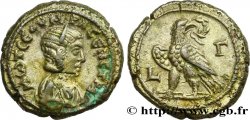
 Descrittivo
Descrittivo